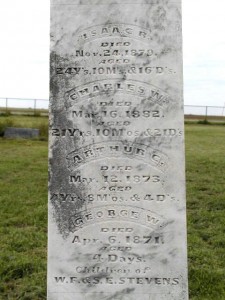This week’s guest post was written by Deb Knoles, a beautiful lady who has known me all of my life, even while I was an angsty teenager, and yet still loves me! She is my second-mama (because everyone needs a second mother…believe me on this) and I trust her wisdom. Enjoy these wise and beautiful words from one who knows.
When I left last November for a week in Canada, the roses were still flinging out vibrant petals of scarlet, coral, and that incredibly soft pink/white that looks and feels like carefully rouged and powdered old lady cheeks. Indian Summer teased us into believing we’d have plenty more days to celebrate the garden.



A week later, I returned to the park to find the roses hanging from their canes, ghosts of former glory, drained of color and turning brittle from a plunge into the deep freeze of a brutal cold snap. Who really believes that the air can move from comfortable 65 degree days to barely 15 in a short week? We do. We live in Illinois.
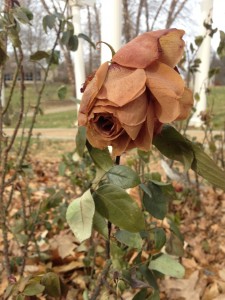
The dying rose beds set me thinking about the false illusion of seasons being the length we think they’ll be (a natural mistake for those living in a state that surely takes its weather cues from menopausal women). The seasons in my own life have tricked me, too. As one of those young shoots coming out of the ground I thought: I’ll never grow up. (That one is sort of true if we’re going to get into maturity issues.) I did grow (physically at least). I did not stay young forever. Eventually, I “flowered” into womanhood and found myself married to my handsome blue-eyed man. Children arrived and I found an entire world of new seasonal misconceptions geared to each stage of their development. My kids will never be potty trained. None of us will survive the teenaged years. The nest will stay empty. But every Season’s master illusion is this: THEN (in the next season), I’ll have time. SOMEDAY, I’ll have time.
Ah, yes. I’ll have time “then”. I thought for sure that would be true NOW. But just as I pushed back the borders of that completely illusive season of “having time”, I became a mother of toddlers again. This time my toddlers are 93 and 89. The term is literal. My parents toddle. Dad uses a walker and Mom uses my arm to counterbalance a back twisted by spinal stenosis, arthritis and scoliosis. They are darling toddlers. For the most part, they are gracious, respectful and endearing. Unless they are cranky, unreasonable and maddening. Pretty much like the younger version of toddlers. Well, really. It’s pretty much like all of us I suspect. It’s just more noticeable to the person who bears the mandate for being a caretaker.
Dead roses and sleeping trees. And my ridiculous notion that I’d someday have “time.” Interesting mind companions for a quick walk around the park. One of the perks of cold weather de-nuding the trees is that the structure of branches is thrown into sharp relief against the sky. You see a tree’s real character in the winter. With the leaves gone, I noticed a tree that has a branch that grew down, dug roots in the ground and then stretched skyward again.
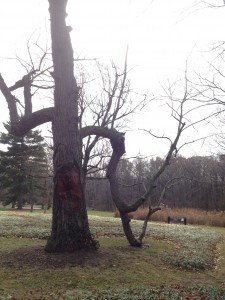
I wonder what drove that branch down so deep. I wonder at the resilience that shot it back up toward the sky after its brush with the ground. What kept it from just hanging out down there and giving in to gravity? There’s a story there in the tree that I will explore “when I have time”. If I have time. The grand illusion still has me in its grip.
Trees have stories. So do people. It’s a little—no, a LOT–intimidating to think what might be revealed in me when the leaves of my younger self have all fallen away. What’s going on under all the foliage?
In my parents I see the structure of a lifetime of good habits. Their discipline to always put everything back in its assigned place means they still live in a clean, well-organized home. (Oh, how I wish that could be said of my home!) They are thankful, gracious people. They’ve built their lives on faith and prayer and considering other people’s feelings and well-being mostly at the expense of their own. Their character holds up even as their bodies break down.
If I were a tree, I’d have collected a good many rings on the old trunk.

While I’m still young enough to camouflage a few of the branches I like to keep hidden, I’ve noticed that some of the leaves in my life have already reached their autumn. The golds and reds are fading to brittle brown and will soon drift away and leave all those branches bare to the wind. Perhaps this season of being a parent to my aging parents is designed to prune out the branches, give some design to the plain limbs and stretch out the stunted growth on others.
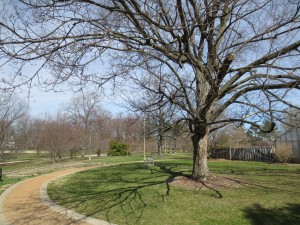

If I could be done with at least some of my selfishness, some of my false sense of pride, some of my striving for goals that don’t matter to anyone but me (and certainly don’t matter to God), perhaps the pattern those limbs trace against the sky would spell out “Glory to God”.
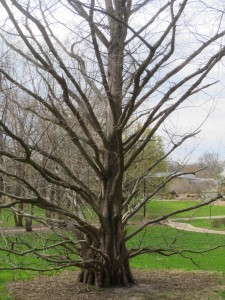

It’s a hard thing to watch these people I love face the very real indignities of aging. Death so often is wielded as a malicious weapon. The golden cord is severed with cruel speed in the too young. But too often for the elderly, as bodies begin to die one part at a time, that thread of life stretches out to the most tortuous tension. It delays a happy homecoming with weary days of travel on unfriendly roads. Dignity gets lost in adult diapers and poor digestion, in weakness and failing vision, and in the frailty of paper thin skin and bones. And still we who love our aged blessings long for more time with them. One more golden memory. One more shared laugh. Is time ever “just enough” for us? I am grateful to know that when it comes, God transforms the sting of death into the most glorious life of all. We’ve just got to trust that His timing will accomplish all that needs to be done even when we vehemently (and mistakenly) think we might have a better suggestion as far as His clock management goes. He never stretches a season too long or ends it too soon for the harvest He reaps. I’m grateful, too, that He asks us only to trust and not to understand. Understanding His timing is so far beyond my grasp.
Whatever our season of life, we can let God use the challenges to shape us into a more beautiful pattern. We can embrace the moment (this one right here and now!), revel in the glories of our season, and live it well. Or we can cling to the deception that we are just marking time till “then” and refuse to trust the Timekeeper. Either way, the clock ticks, the hours pass and the imprint shows up on our souls. Eventually, it will be evident to all what was real and what was just Spring’s window dressing.


